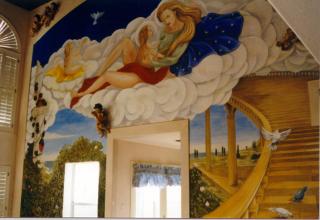LAST EDITED ON 08-Sep-01 AT 03:28 AM (PST)

The Albuquerque Fresco by Ilia Anossov is a paradigm of a brilliant modern fresco. Its technique is on the Grande scale. Viewing it is reminiscent of watching a gigantic film, for this fresco incorporates not only cinematic techniques, and reminders of the most brilliant art, but also resounds of the painting of late modern artists with a flair for whimsy, like Jean Miro, and Paul Klee. At the same time there are images and techniques which evoke paintings of early masters. God pointing a finger in creating MAN comes to mind. The size and art of the fresco imparts a larger than life enveloping feeling, as one gazes at it. One cannot recapture the reality of the fresco at a website, but only get a faint idea of the scale and imagery.
It is as though the fresco artists have honed a living and breathing creature Fresco is public art rather than "elite" art. It is also a common effort of the artist, plasterer and others involved in the process. Frescoes created for all people to see and enjoy, and do not require extensive education to understand and analyze their significance. Granted there will always be scholars and art critics who take apart every art work, but frescos are made for the collective enjoyment. Frescos depict the most cherished cultural aspects of any civilization in their attitudes. At this moment in time, we are plagued with technology. Do we answer the phone, check e-mail, burn a CD, or download a file? Hi tech stuff! Viewing a fresco puts one in mind of timeless, labor intensive, painstaking work. It's at the opposite pole . If you looked inside the plaster as a fresco is created, you would see how the water soaks in and draws in and manipulate the pigment. Here, the artist and the plasterer become one with the art work, being careful to watch for "spots" that need brushwork immediately. In viewing and executing frescos, one reaches for the sky, contemplates lofty aims, strives to define essence.
Fresco is an unique form of painting. The oldest fresco, painted on cave walls, has outlasted many other forms of painting. Fresco endures, environmentally because of its mineral nature therefore resistant to the effects of time, and aesthetically because fresco art equally applies to the populace and to the elite. It is art for all.
Frescoes are paintings on freshly spread lime plaster, with water-based pigments. The word is high German originally, came into Italian, and means "fresh". Fresco is a collaborative art. One person cannot execute a fresco. It requires teamwork, stamina and creativity. It is also a public art. The history of fresco art goes back more than 30,000 years, dating from cave walls on which the people drew figures to mark their activities, passions and culture. They depict oceanic concepts: love, hate, liberty, brotherhood. Many early frescos incorporated allegories; so, there were universal themes rather than personal themes to indicate the truths of human experience. The modern forms still depict civic figures and heroic ideals. It is different from other art forms since it blends with its surroundings. Traditionally, frescoes are not framed; the building's interior presents the frame. Some of the lofty ideals in fresco are painted to indicate 'arete', the ancient Greek word for honor or moral perfection. Today, we would say arete refers to principles.
http://www.truefresco.com/albuquerque.html
